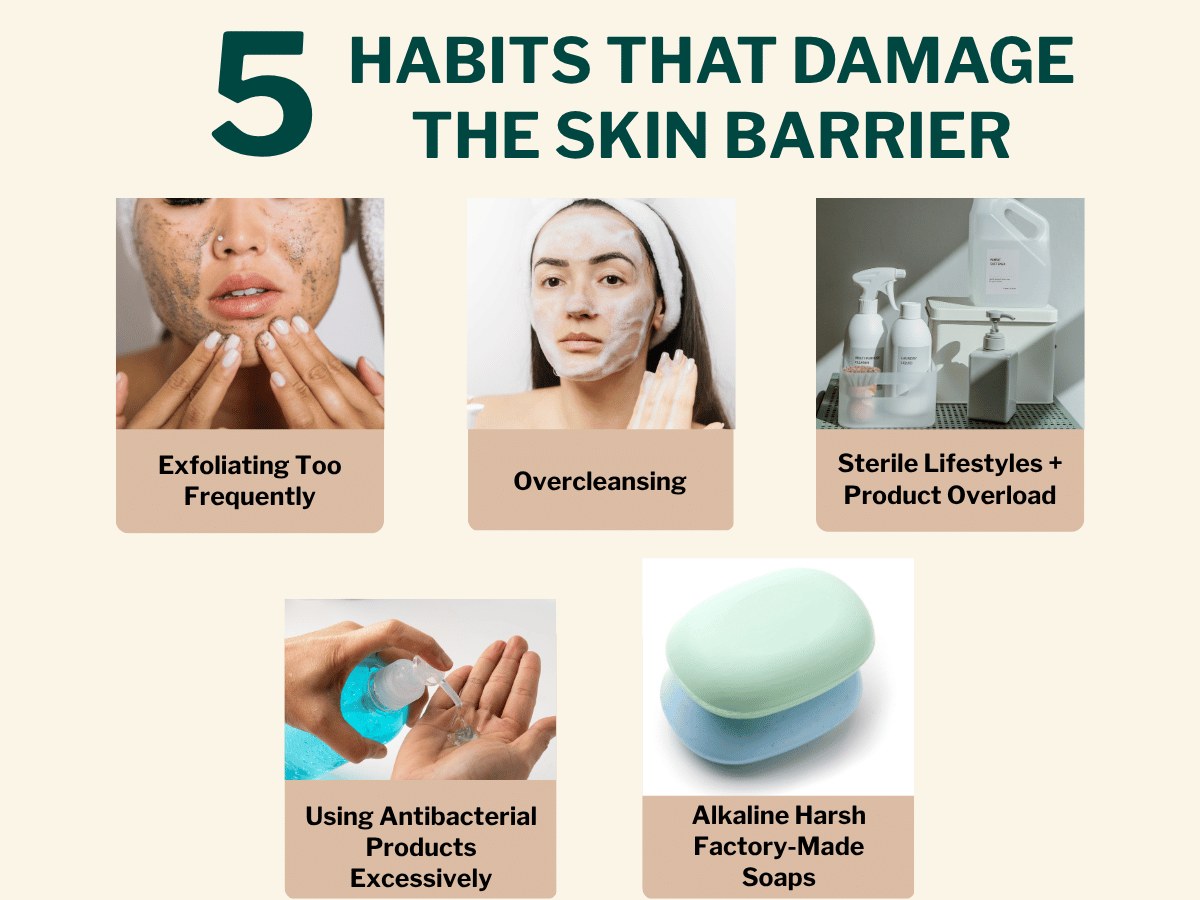At Oleum Cottage, we’ve seen it too many times: someone walks in with red, reactive, overly sensitive skin, unsure of what went wrong. Their routine is clean, expensive, and often minimal. And yet their skin flares up at the slightest touch.
Sound familiar? You’re not alone. What many experience as "sensitive skin" is often the outcome of a disrupted skin barrier and imbalanced microbiome. And ironically, the very products and habits designed to “cleanse,” “clarify,” or “reset” your skin might be doing the opposite. This guide on sensitive skincare explains why even gentle products can trigger flare-ups.

What Is The Skin Barrier— And Why Does It Matter?
Think of your skin barrier as the frontline fortress: a delicate layer made up of lipids, proteins, and skin cells that lock in moisture and keep out irritants. When it's strong, your skin feels calm, hydrated, and resilient. When it’s weakened, even the gentlest products start to sting.
But your skin barrier doesn’t act alone.
Meet Your Skin Barrier’s Invisible Ally: The Microbiome
Your skin is home to trillions of microbes—bacteria, fungi, and viruses—that protect against infections, regulate inflammation, and support healthy oil production. This ecosystem is called the skin microbiome. When it’s thriving, your skin stays balanced. When it’s disrupted, conditions like eczema, rosacea, and acne flare up.
A 2021 research from Frontiers in Microbiology confirms that disruptions in this microbial balance (called dysbiosis) are directly linked to common skin disorders. And unfortunately, many of our modern skincare habits are unknowingly causing this imbalance.

How Do I Know That My Skin Barrier Is Damaged?
If your skin suddenly feels dry, tight, itchy, or inflamed, your skin barrier might be compromised. A damaged skin barrier can’t lock in moisture or keep out irritants—and that’s when skin starts acting up.
Common Signs of a Damaged Skin Barrier:
-
Persistent Dryness or Flakiness – Even after moisturizing, skin feels parched.
-
Sudden Sensitivity – Products that once worked fine now cause stinging or redness.
-
Itching or Burning – A sign your skin is reacting to something it shouldn’t.
-
Breakouts and Red Patches – Especially if they show up in areas that weren’t acne-prone before.
-
Tightness After Cleansing – Especially with foaming face washes or chemical exfoliants.
-
Shiny but Dry Skin – That odd mix of greasy surface and dry texture could be your skin barrier crying for help.

5 Habits That Damage The Skin Barrier And Microbiome
1. Overcleansing
Cleansing too often—especially with foaming or micellar cleansers—strips away natural oils and reduces microbial diversity. This weakens your lipid layer and reduces good bacteria like Staphylococcus epidermidis, leaving skin vulnerable to irritation and dehydration.
Signs your skin is over cleansed: Tightness after washing, flaky patches, increased oiliness, and unexpected breakouts.
Fix: Switch to a balm or oil cleanser that respects your skin's natural moisture barrier. Oil cleansing doesn’t disrupt the microbiome—it nourishes it.
2. Exfoliating Too Frequently
Whether it’s scrubs, AHAs, BHAs, or enzyme peels, over-exfoliating removes not just dead skin, but also the microbial ‘habitat.’ Within just 72 hours of excessive exfoliation, micro-inflammation can set in and beneficial microbes start to diminish.
If your skin stings from basic moisturisers or develops random red patches, your barrier may need a reset.
3. Using Antibacterial Products Excessively
Excessive use of antibacterial soaps, hand washes, alcohol-free hand sanitizers and disinfectant wipes with ingredients like triclosan or benzalkonium chloride kill both harmful and beneficial microbes. This reduces your skin’s natural immunity and may worsen conditions like eczema, especially due to overgrowth of Staphylococcus aureus.
Longer healing time, frequent flare-ups, and acne that doesn’t respond to treatment can all signal microbiome imbalance.
Result: Lowered skin immunity, delayed healing, and overgrowth of bad bacteria like Staphylococcus aureus (often linked to eczema).
Fix: Ditch antibacterial soaps unless medically necessary. Switch to handmade soaps and trust your microbiome to do its job.
4. Alkaline Harsh Factory-Made Soaps
Most commercially-made bar soaps have a pH well above 8, stripping the skin of natural glycerin and disturbing its ideal acidic environment (pH 4.5–5.5). This makes it harder for good bacteria to survive.
The result? Either persistently dry, flaky skin—or rebound oiliness and acne.
5. Sterile Lifestyles + Product Overload
Indoor living, minimal contact with nature, and using too many synthetic products all reduce the microbial diversity your skin needs. Over-sanitising your surroundings and using too many sterile products can create hypersensitive skin and reactive skin that flares with even minor triggers like weather or low level stress.
Fix: Reconnect with nature, simplify your routine, and repair skin barrier with these gentle, microbiome-safe home remedies.

How Do You Rebuild a Damaged Skin Barrier Naturally?
One of the most effective ways to restore skin barrier is by switching to Activated Oils™️—a blend of cold-pressed carrier oils and therapeutic grade essential oils in microbiome-safe concentrations.
Cold-pressed oils like jojoba, sunflower, argan, rosehip, and sesame are rich in fatty acids, antioxidants, and skin-identical lipids. They mimic the skin’s natural sebum, rebuild the lipid matrix, reduce transepidermal water loss, and create an environment where your microbiome can thrive.
Essential oils, when used in skin-safe doses, add a therapeutic layer. Lavender, chamomile, and geranium calm inflammation and support microbial balance. Tea tree oil—when used cautiously—targets only harmful strains of bacteria without disturbing beneficial ones.
This isn't theory—it’s something we've seen time and again at Oleum Cottage. Within days of switching to these microbiome-supportive oils, people notice less tightness, reduced redness, and improved hydration. With long-term use, your skin builds resilience to temperature, stress, and product changes.
Here’s what our community has told us:
-
“My skin used to burn with even water. Just a week after switching to Activated Oils™️, the redness calmed down.”
-
“It feels like my skin finally remembers how to function on its own again.”
The goal isn’t to have “perfect” skin. The goal is balance. Because healing isn’t about perfection. It’s about restoring what’s already within. Support your skin barrier. Nourish your microbiome. Trust in nature’s intelligence. And when in doubt, go back to simplicity.
If your skin is feeling overwhelmed, explore our range of natural skincare for sensitive skin rooted in plant oils and barrier-repair science—created to work with your skin, not against it.


